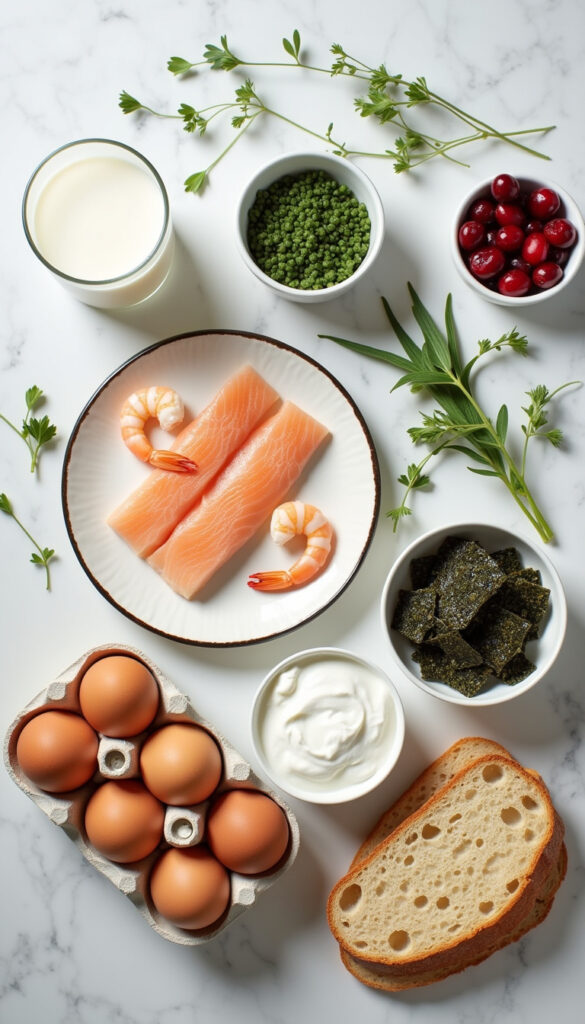Iodine rich foods play a crucial role in your thyroid health, yet many Americans don’t get enough of this essential mineral. Let’s explore the best dietary sources to keep your body functioning optimally.

Why Your Body Needs Iodine
Your thyroid gland depends on iodine to produce hormones that control your metabolism, heart rate, and body temperature. Without enough iodine, you might experience fatigue, weight gain, hair loss, and difficulty concentrating. The recommended daily intake varies by age:
- Adults: 150 micrograms
- Pregnant women: 220 micrograms
- Breastfeeding women: 290 micrograms
- Children: 90-120 micrograms
Unfortunately, iodine deficiency affects nearly 2 billion people worldwide. In the United States, iodine levels have dropped by more than 50% since the 1970s.
Top Seafood Sources of Iodine
Seafood contains the highest amounts of natural iodine because ocean water is rich in this mineral. Here are your best options: Fish:
Take Charge of Your Health with The Home Doctor
Discover real-world remedies and first-aid solutions you can use when help isn’t around.
👉 Claim Your Home Doctor Guide- Cod: 158 micrograms per 3 oz serving
- Tuna: 17 micrograms per 3 oz serving
- Salmon: 58 micrograms per 3 oz serving
- Sardines: 35 micrograms per 3.5 oz serving
- Halibut: 164 micrograms per 3 oz serving
Shellfish:
- Shrimp: 35 micrograms per 3 oz serving
- Lobster: 100 micrograms per 3 oz serving
- Scallops: 135 micrograms per 3 oz serving
- Crab: 26-50 micrograms per 3 oz serving
Sea Vegetables:
- Kelp: 2,984 micrograms per tablespoon (be careful with portions)
- Nori: 16-43 micrograms per sheet
- Wakame: 66 micrograms per tablespoon
- Dulse: 35 micrograms per tablespoon
Dairy Products Rich in Iodine
Dairy products contain iodine because farmers use iodine-based cleaning solutions for milking equipment and cows consume iodine-fortified feed. Milk and Yogurt:
- Milk: 56-116 micrograms per cup
- Greek yogurt: 87 micrograms per cup
- Regular yogurt: 75 micrograms per cup
- Buttermilk: 26 micrograms per cup
Cheese Options:
- Cottage cheese: 65 micrograms per cup
- Cheddar cheese: 12 micrograms per ounce
- Mozzarella: 6 micrograms per ounce
- Swiss cheese: 8 micrograms per ounce
Egg-cellent Iodine Sources
Eggs provide a convenient way to boost your iodine intake. One large egg contains about 24 micrograms of iodine, mostly found in the yolk. The iodine content depends on what the hens eat and their living conditions. Free-range and organic eggs often contain higher iodine levels than conventional eggs. You can easily incorporate eggs into your daily routine through:
- Scrambled eggs for breakfast
- Hard-boiled eggs as snacks
- Egg salad sandwiches
- Baked goods and cooking
Fruits and Vegetables with Iodine
While fruits and vegetables generally contain less iodine than seafood and dairy, some options can contribute to your daily intake: Fruits:
- Cranberries: 400 micrograms per 4 ounces
- Strawberries: 13 micrograms per cup
- Pineapple: 2 micrograms per cup
- Bananas: 3 micrograms per medium banana
Vegetables:
- Navy beans: 32 micrograms per cup
- Lima beans: 8 micrograms per cup
- Corn: 14 micrograms per cup
- Green peas: 3 micrograms per cup
- Potatoes: 60 micrograms per medium potato with skin
The iodine content in produce varies greatly depending on soil conditions where they’re grown. Coastal areas typically have higher iodine levels in their soil.
Iodized Salt and Other Fortified Foods
Iodized salt remains one of the most reliable sources of iodine in the American diet. One-quarter teaspoon contains about 71 micrograms of iodine. Other Fortified Options:
- Fortified bread: 35 micrograms per slice
- Fortified cereals: varies by brand
- Fortified plant-based milk: check labels
- Multivitamins: typically 150 micrograms
Remember that sea salt, kosher salt, and specialty salts usually don’t contain added iodine unless specifically labeled as iodized.
Grains and Iodine Content
Some grains naturally contain small amounts of iodine, while others are fortified during processing:
- Enriched white bread: 35 micrograms per slice
- Whole wheat bread: 5 micrograms per slice
- Rice: 1.4 micrograms per cup
- Pasta: 36 micrograms per cup (varies by brand)
- Oats: 6 micrograms per cup
Commercial bakeries often use iodine-containing dough conditioners, which increases the iodine content in bread and baked goods.
Foods That Can Block Iodine Absorption
Some foods contain compounds called goitrogens that can interfere with iodine absorption when eaten in large amounts: Cruciferous Vegetables:
- Broccoli
- Cauliflower
- Brussels sprouts
- Cabbage
- Kale
Other Foods:
- Soy products
- Sweet potatoes
- Lima beans
- Cassava
You don’t need to avoid these healthy foods completely. Cooking reduces their goitrogenic effects, and eating them in normal amounts alongside iodine-rich foods shouldn’t cause problems.
How to Include More Iodine in Your Diet
Here are practical ways to boost your iodine intake: Breakfast Ideas:
- Greek yogurt with berries
- Scrambled eggs with cheese
- Milk in your cereal or coffee
- Fortified bread toast
Lunch Options:
- Tuna salad sandwich
- Cottage cheese with fruit
- Seafood soup
- Seaweed salad
Dinner Suggestions:
- Baked cod with vegetables
- Shrimp stir-fry
- Salmon with rice
- Lobster bisque
Snack Ideas:
- Hard-boiled eggs
- String cheese
- Yogurt parfait
- Trail mix with dried cranberries
Signs You Might Need More Iodine
Watch for these potential symptoms of iodine deficiency:
- Unexplained weight gain
- Fatigue and weakness
- Hair loss or thinning
- Dry, flaky skin
- Feeling cold frequently
- Difficulty concentrating
- Heavy or irregular periods
- Slow heart rate
If you experience several of these symptoms, consult your doctor for proper testing and evaluation.
Special Considerations for Different Groups
- Pregnant Women: Need extra iodine for proper fetal brain development. Focus on dairy products, eggs, and seafood while avoiding high-mercury fish.
- Vegetarians: May have lower iodine intake since they avoid seafood. Emphasize dairy products, eggs, iodized salt, and sea vegetables.
- Vegans: Face the highest risk of deficiency. Consider fortified plant milks, nutritional yeast, and seaweed, but may need supplements.
- Children: Need iodine for proper growth and brain development. Milk, yogurt, and eggs are kid-friendly options.

Lifebing is driven by an unrelenting passion for promoting health and well-being, our team is wholly committed to curating exceptional content and immersive experiences.
